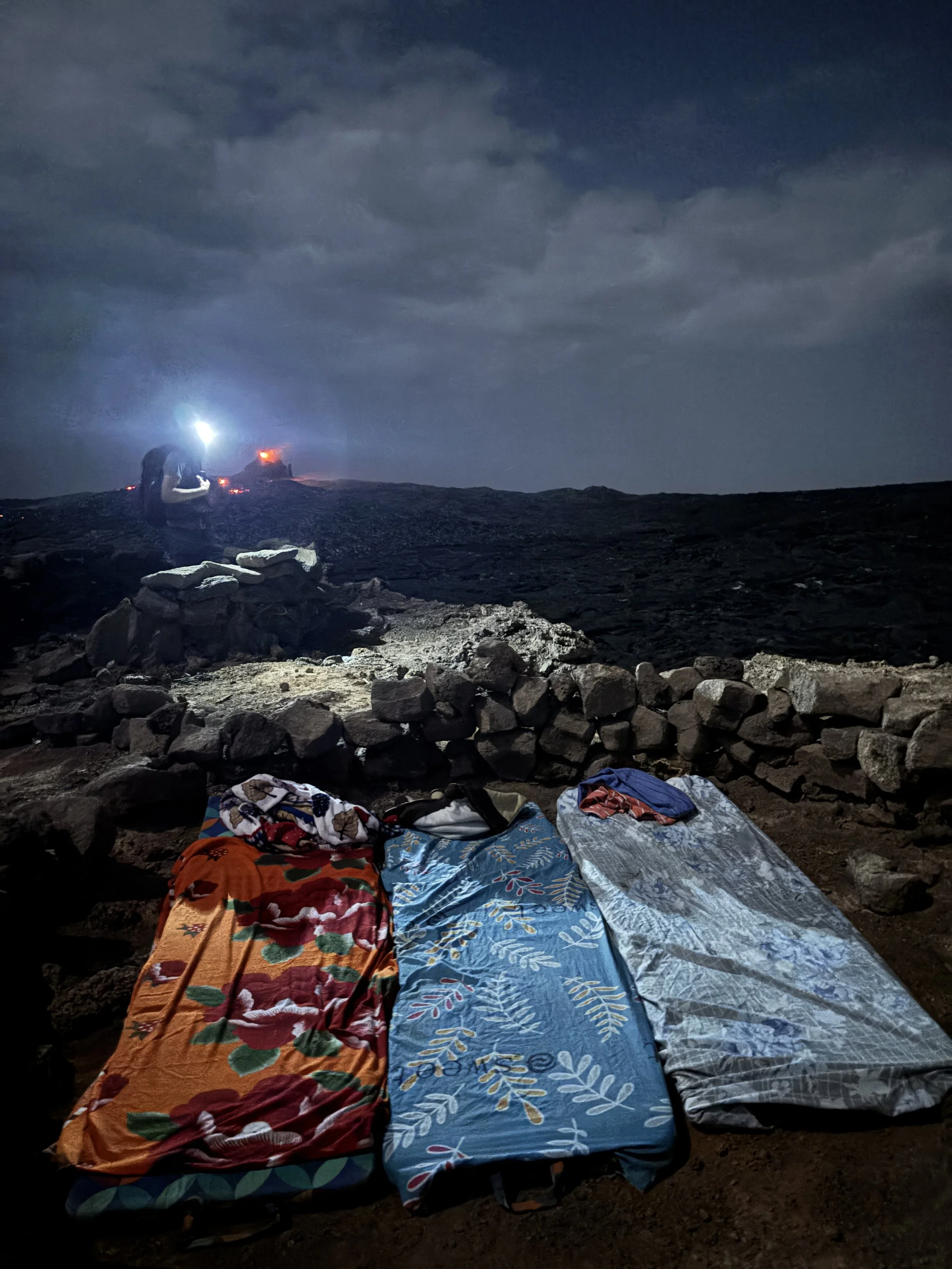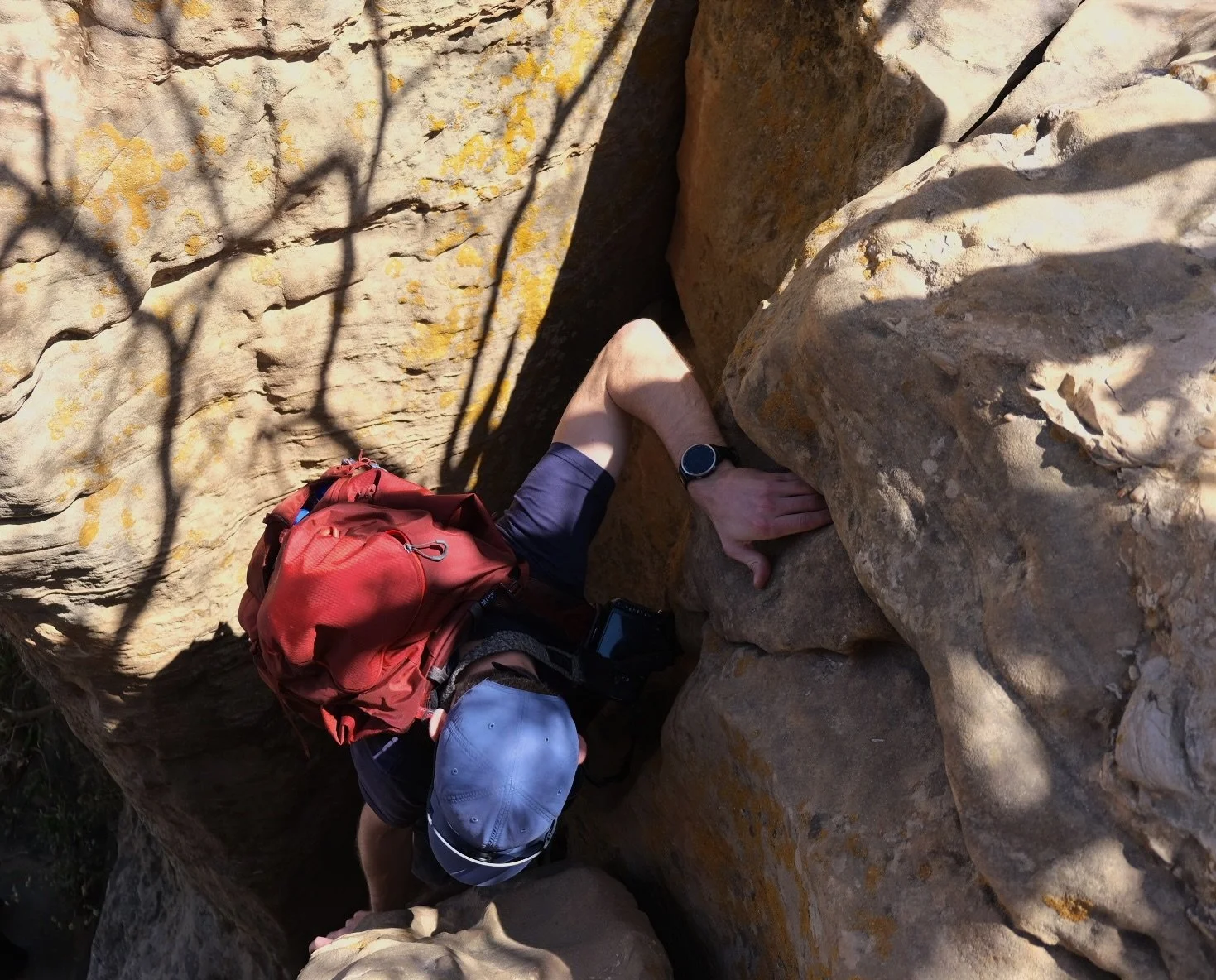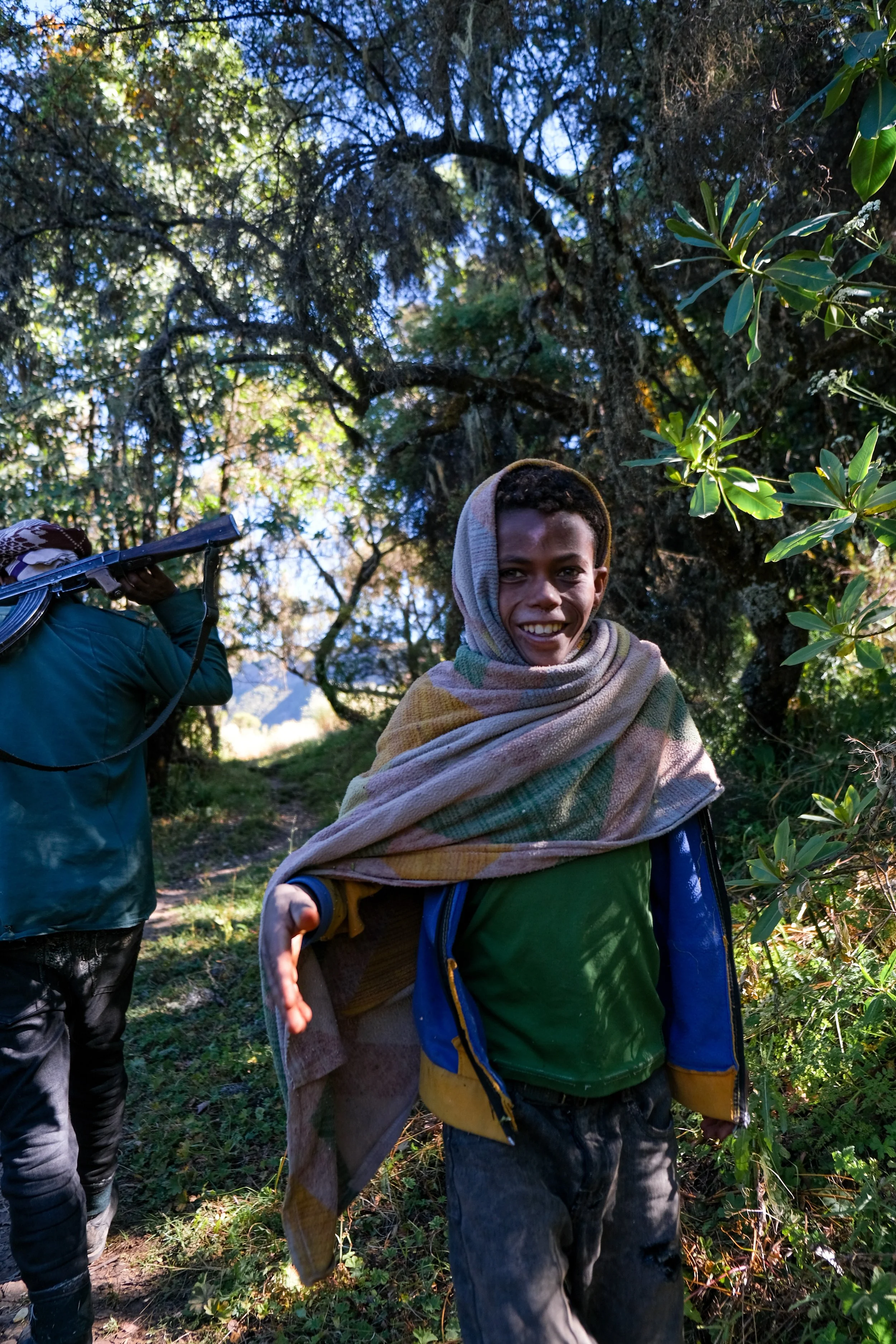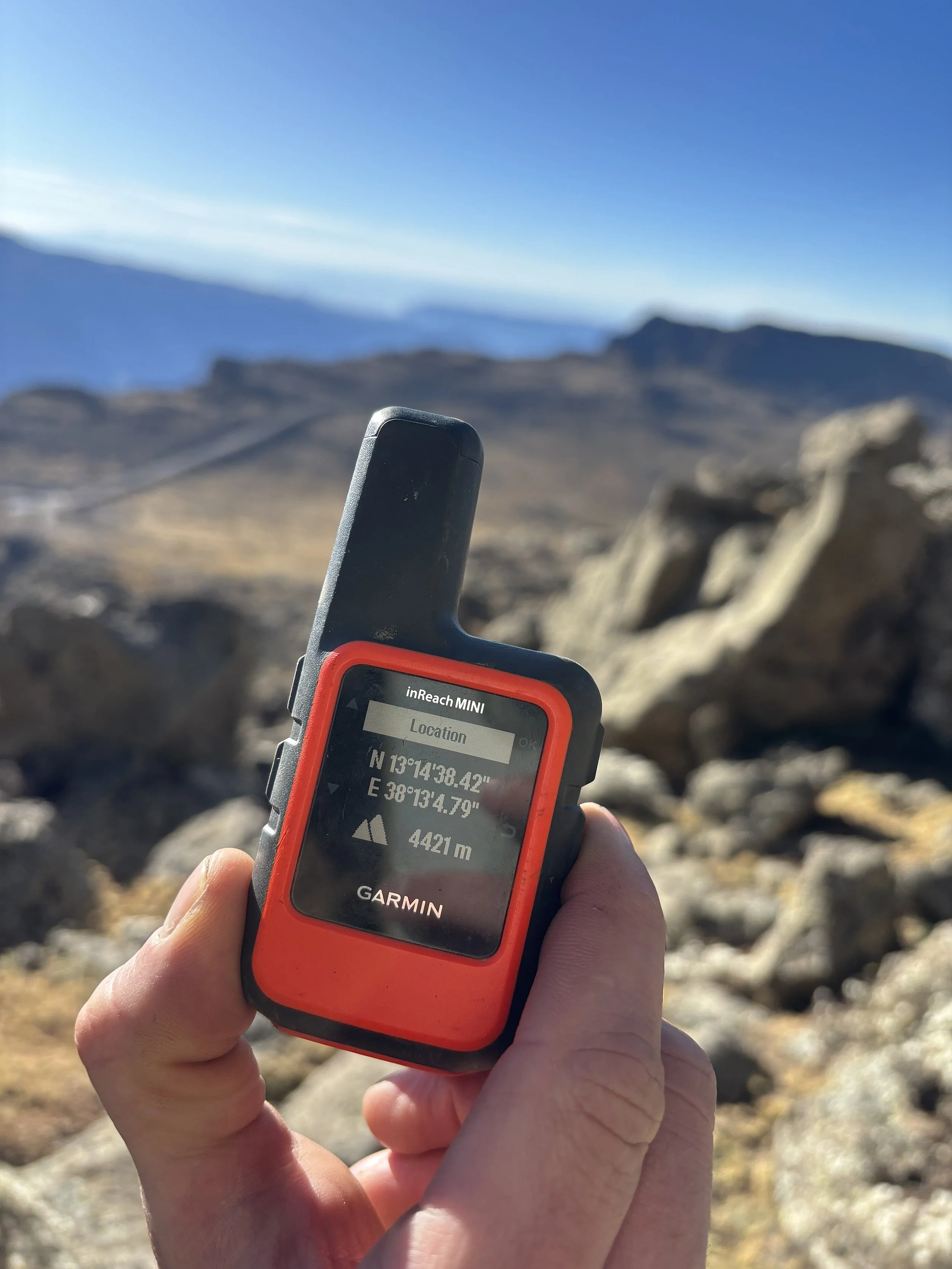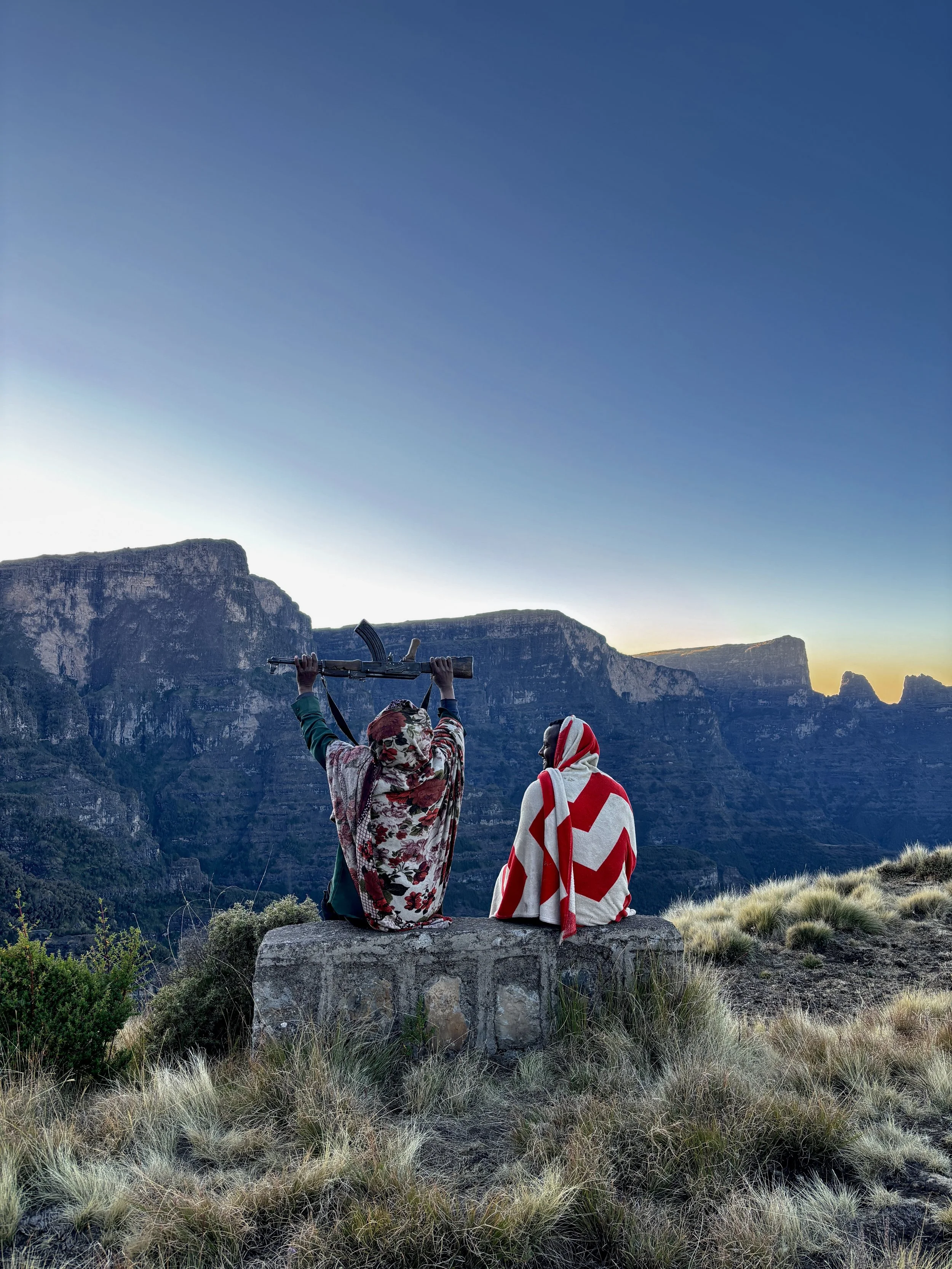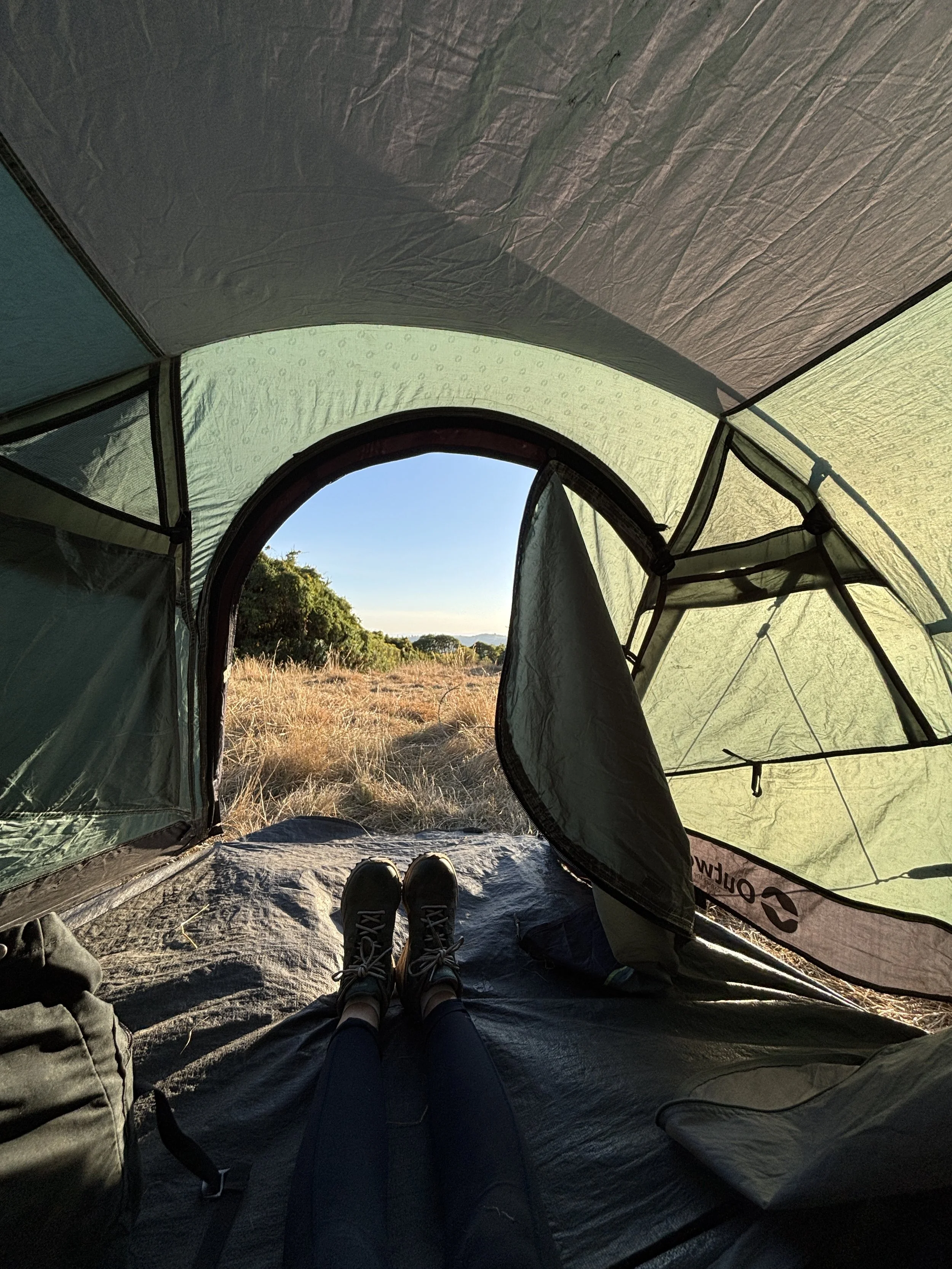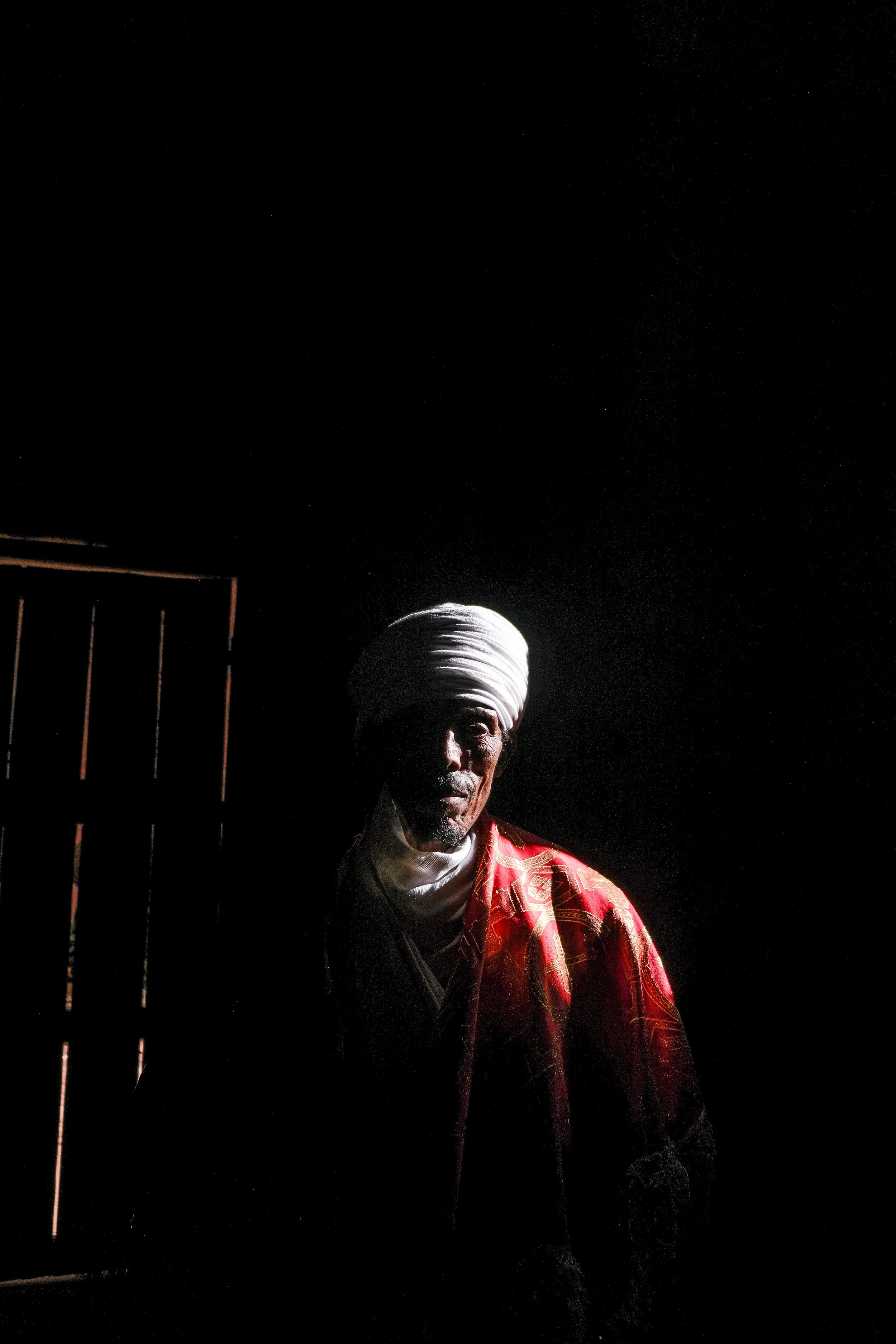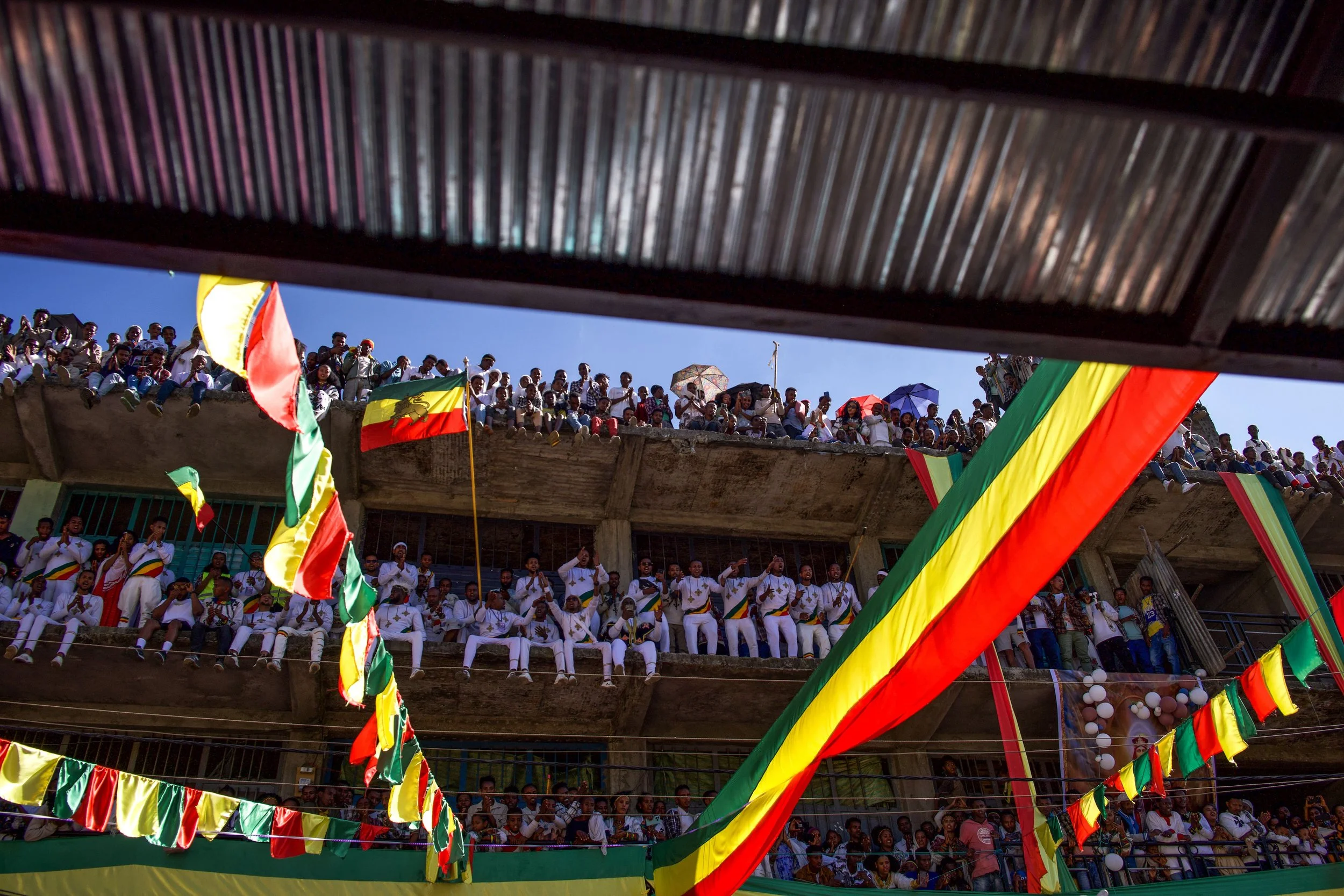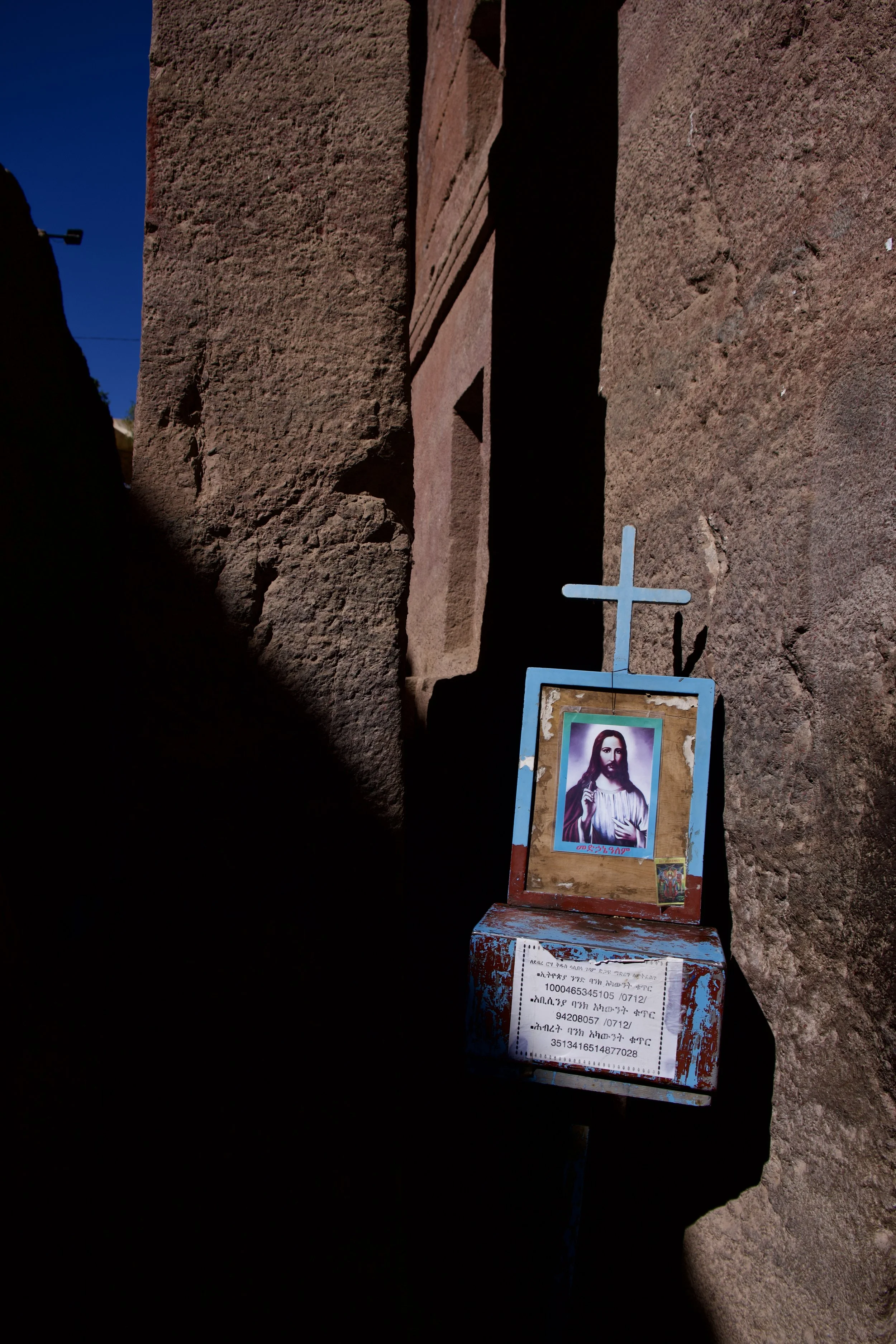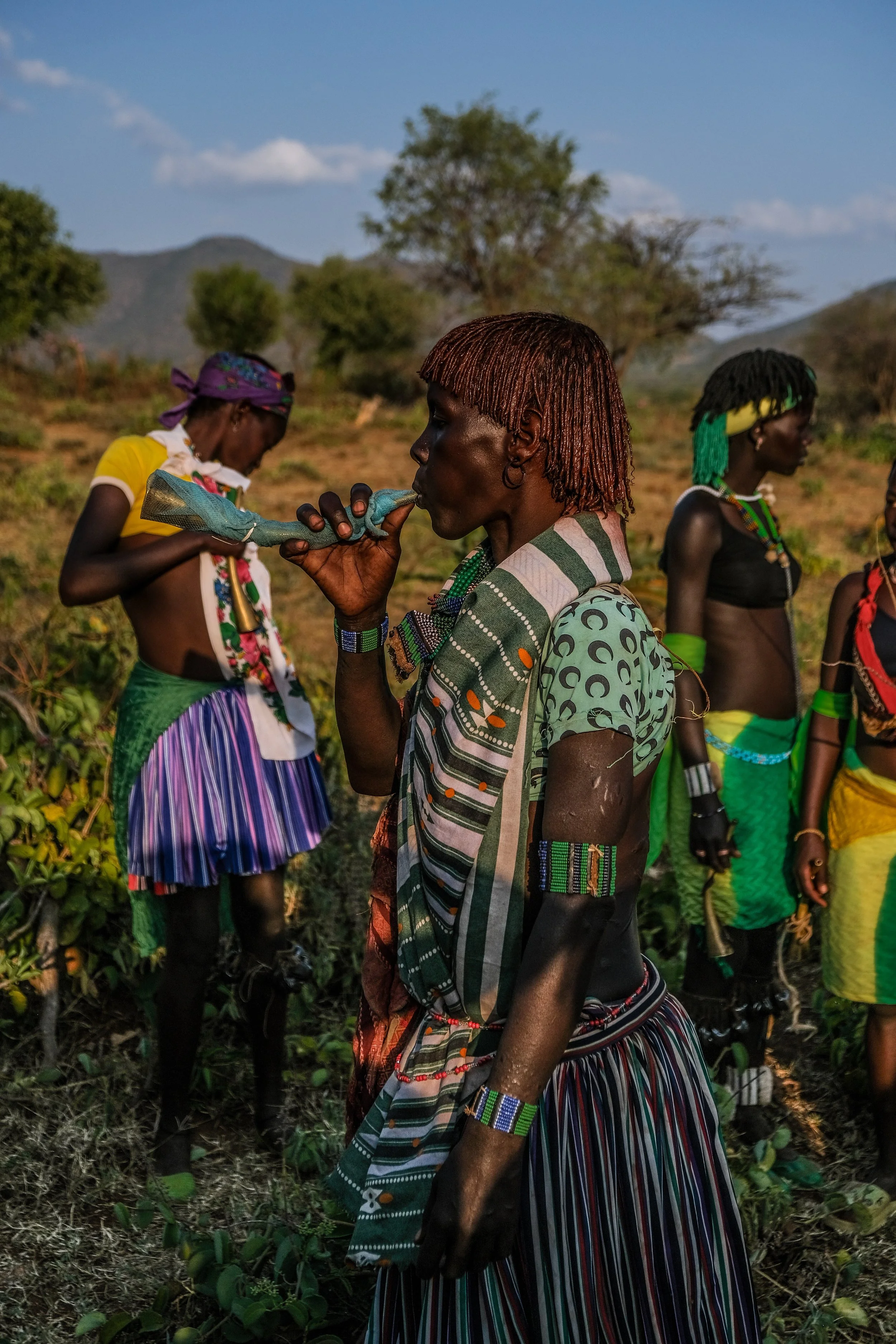
A Month in Ethiopia.
From volcanoes to rock-hewn churches, the birthplace of humanity reveals how, even in 2025, climate, faith, and tradition remain intertwined.
By the time I reached the base of Erta Ale, an active volcano whose name means “smoking mountain,” it was close to two in the morning. As I strapped on my headlamp, I listened to the low, guttural spluttering of lava, thinking about how less than twenty-four hours earlier I’d been sitting under fluorescent lights in Washington, D.C.
The hike took about an hour. At the top by a flat ridge, we laid down some mattresses. Then Arre motioned for us to continue, down into the volcano’s caldera — which, looking back, wasn’t smartest thing I’ve ever done. I followed behind him as he tapped freshly cooled lava with a stick before taking a step forward. It’s crusted surface was black, thin, and deceptive. It felt as if we were walking on charred eggshells, or meringue. Every so often one of us would fall through a layer of crust with one foot and a sharp crack — we’d pause, catch our breath, and redirect.
The closer we got to the mouth of the volcano, the hotter and brighter it became, like a sauna’s heat that throbbs against the skin. The eruptions were constant and violent, an almost-defeaning ‘psh-psh’ sound of molten rock meeting air. It was hard not to feel very small.
Hours later, from behind a small wall of rocks, we watched from our mattresses as the volcano spit orange light into the night. By morning, a thin layer of soot covered everything, including our faces.
Erta Ale, Afar Region
Our mattresses on the side of Etra Ale.
Our trusty vehicle, pre soot layer.
The morning prior, I’d flown to Addis Ababa, then north to Tigray, a region still recovering from one of Africa’s most devastating modern conflicts. Between 2020 and 2022, the Tigray War pitted regional forces against the Ethiopian government, leaving more than 600,000 people dead and displacing millions. Traveling by road in this region remains dangerous, so the only reliable way north is by air.
In Tigray, I met Arre, a local guide with a gentle voice, dreadlocks, and a weathered 4x4. Together we drove nearly ten hours across some of the worst roads I’ve experienced in Africa: ones made of sharp rock, sand, and volcanic debris that turned every mile into a test of patience. The air was dry and metallic, as if filtered through dust and heat.
After a night on Etra Ale, we descended into the Danakil Depression, one of the lowest and hottest places on Earth, a landscape formed by the continental drift of three tectonic plates.


Danakil Depression, Northeast.
The scenery in Danakil looked as tortured and inhospitable in real life as it does in these photos: acidic pools of green and yellow, cracked salt plains stretched into sharp geometry. Standing there, it was impossible not to think of Mars, or how easily this part of Earth could pass for something extraterrestrial.
A few days later, we arrived in Hawzen, home to some of the world’s highest monolithic churches. Carved centuries ago into the cliffs, these structures sit high above the valley so that worshippers can be, as the priests say, “closer to God.” The climb takes several hours. Near the top, we removed our shoes for better traction on the steepest sections.
When you reach the top of Abuna Yemata Guh, which translates to “Chapel in the Sky,” a priest, Atsbeha Asefa Hagos, can be found. Each day, he climbs up and down the 250 meter cliff face, spending his time inside a shallow cave carved into the mountain. He holds services here on a regular basis, and villagers often climb up to worship, pray, or get baptized.
Hawzen, Tigray Region
My brother Max, during the ascent to Abuna Yemata Guh.
Arre, leading the way to Maryam Korkor.
Priest Atsbeha Asefa Hagos, at 2,580 meters.
A porter helping guide the way.
The view from Maryam Korkor.
In Axum, another of Ethiopia’s holy cities, people spoke about America with longing. They described it as a place of opportunity and prosperity — they said Trump came across as a strong leader. Meanwhile, back in the U.S., Trump’s second term was beginning to unfold, one moving to close the doors to many of the people who still saw it as a refuge.
One of the most obvious influences of American culture was the celebration of rap artists. In every city I visited, the tuk-tuks — or bajajs, as they are called in Ethiopia, are plastered with posters of Tupac Shakur. His face appeared, unexpectedly, everywhere: on t-shirts, on taxis, painted onto the backs of minibuses. Biggie surfaced too, but far less often. Tupac seemed to have survived not just death, but translation.
Axum, Tigray Region.
Tupac bajaj.
Injera with missir and shiro.
Bajaj alongside a horse and carriage.
From Aksum, we traveled southeast into the Simien Mountains, one of the highest ranges in Africa. We spent three nights and four days hiking Ethiopia’s tallest peaks — Ras Dashen rises to 4,550 meters.
The air was thin and the nights were cold, a shock after the desert. Sai’id led the way, a local scout who carried an assault rifle (pictured on the left). We slept in tents, and by the second morning I was fairly sure I’d picked up bed bugs from my borrowed sleeping bag. The terrain made up for it though: a mix of high plateaus and sheer basalt cliffs, with lush juniper–hagenia woodlands and patches of giant lobelia plants in the open meadows.
Simien Mountains, Highlands.
Sai’id introduces us to his friend, a young boy who lives in the highlands.
Lalibela, the “Jerusalem of Africa.”
In Lalibela, a town in the Amhara region, the main attraction are a series of churches carved entirely from volcanic rock, built over eight centuries ago. The spaces were cool and dim, the stone a beautiful deep rust-red color. Light entered not through windows but through hand-carved cracks, often taking the shape of a cross, as seen below. Since the twelfth century, Lalibela has been a center of Ethiopian Orthodox Christianity. Its eleven rock-hewn churches, each chiseled by hand from a single block of basalt, remain an active site of Christian pilgrimage. Priests in lavish robes move through the stone tunnels that link one church to another, carrying bibles with pages made from goat skin. Many have lived here since they were children, taken in as acolytes and raised by other priests.
They speak Ge’ez, an ancient liturgical language distinct from Amharic, Ethiopia’s national tongue. To speak with them, I relied on a translator. Their rhythm of speech was slow and deliberate. It felt more like prayer than conversation.
And yet, despite the sanctity of these spaces, they are dissolving. Erosion gnaws at the carved facades; rising heat and humidity has accelerated the spread of microorganisms that eat away at the stone. Hairline cracks run through walls.
I am told that preservation efforts exist, but funding is scarce. Metal shelters built years ago by UNESCO to shield the churches from rain, now trap moisture and heat. Essential restoration work has stalled, caught between bureaucracy and neglect.
It’s difficult to stand in Lalibela’s churches and not think about the fragility of faith’s architecture — how even the most sacred sites are fated to crumble under the slow (and fast) violence of global warming. Climate change is altering the world’s religions in ways we rarely acknowledge.
For now, Lalibela’s future, like so much else, feels uncertain.
Gondar, Amhara Region.
Across Ethiopia, drought and shifting weather patterns are reshaping both landscapes and living traditions. Nowhere is this more visible than during Timkat, the annual Orthodox Christian celebration in Gondar that commemorates the baptism of Christ. The moat surrounding Fasilides Church — once filled naturally by rainfall — must now be filled by hose.
Timkat is one of the country’s largest religious festivals. It’s a three-day (and night) celebration of renewal and devotion. This year Timkat was particularly meaningful: many Ethiopians were gathering fully for the first time since the Tigray War and the pandemic. Nearly half a million people came together in Gondar.
The scarcity of water did little to dampen the mood. After hours of processions that began well before dawn, a senior priest blessed the waters, and the crowd erupted. By this time the sun had risen. People leapt from tree branches and the shoulders of friends, diving, flipping, cannonballing into the moat, clothed and unclothed alike. It was pure, joyous chaos: shouts, laughter, the heavy smacks of bodies meeting water. Parents and women watched from the edges, holding their phones and purses above their heads to avoid getting wet.
When I spoke with people about their lives, rising heat and erratic rains were a common challenge. Climate change seemed to touch faith, harvests, and businesses. For those whose traditions and livelihoods depend on nature, the disruption was described to me as both physical and spiritual.
I often wonder, and fear, how faith will adapt as the climate reshapes not only the earth, but the ways we find meaning in it.
Sophia (seen kneeling above) borrows my camera and models with her friends.
Two women give each other haircuts before the Hamer whipping ceremony.
In the Omo Valley, I traveled with Bereket, a guide from Jinka who spoke several of the local languages and had known many of the families for decades. He translated as we moved from village to village, but much was inevitably lost. I wanted to ask people directly what they thought about the changes taking place around them.
Omo Valley, Southwest.
Women from the Dassnech Tribe encircle a singing girl.
Across the valley, communities such as the Mursi, Kara, and Dassnech have come under increasing pressure from development projects and government resettlement plans. The construction of the Gibe III Dam and the expansion of large-scale agriculture have altered the region’s ecology and economy, forcing some groups to leave ancestral territory along the Omo River. For the Mursi, the loss of fertile floodplains has made herding and small-scale farming far more precarious.
A member of the Hamer Tribe blows a horn to signify the commencement of the whipping ceremony.
A member of the Hamer Tribe prepares sorghum, which later gets cooked over coal.
Despite Bereket’s relationship with Tribe members, I felt conflicted. Curiosity and respect are uneasy companions and visiting these communities felt both like a privilege and a trespass. Many families rely on tourism for income, yet the same exchange can distort what it means to be seen. The line between cultural sharing and spectacle is thin, and I wasn’t always sure which side I stood on.
Some traditions were uncomfortable to watch. During a Hamer “whipping ceremony,” young women were struck by men with thin branches, leaving their backs streaked with blood. The scars, I was told, symbolize strength and beauty — a rite of passage. The women laughed as they were being struck, seemingly enjoying the process. The ritual takes place with or without people watching, yet I couldn’t help feeling complicit. Their wounds were left open and untreated.
A young man whips a member of the Hamer Tribe.
An alcoholic beverage is served from a coconut.
A member of the Karo Tribe sits outside his home.
My last evening in Addis, I caught a ride in a bajaj into town. Little yellow, green, and red flags lined the roads ahead of us, remnants from Timkat. This particular bajaj caught my eye for one reason — a massive fading Tupac poster covered the entire back panal. When I asked the driver what kind of music he liked, he grinned, cranked the volume knob, and to my surprise, queued up some Nicki Minaj.
Outside, the sky was turning gold. To Minaj’s “Starships,” we drove into the evening, passing bajaj after bajaj with Biggie, Nas, and Pac, and I wondered whether seeing the world more closely makes it any easier to understand.
—
Acknowledgments
My deepest gratitude to the local guides — Solomon, Arre, Mile, King, Alex, and Bereket of @omoregiontours and @arretours — for sharing their knowledge, stories, and injera with me. This trip wouldn’t have been possible without them.
